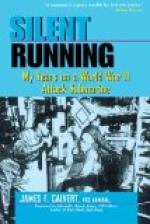With him I went to see what the ruins of Neuve Chapelle looked like by daylight. The destruction was not all the result of one bombardment, for the British had been shelling Neuve Chapelle off and on all winter. Of course, there is the old earthquake comparison. All writers have used it. But it is quite too feeble for Neuve Chapelle. An earthquake merely shakes down houses. The shells had done a good deal more than that. They had crushed the remains of the houses as under the pestle-head in a mortar; blown walls into dust; taken bricks from the east side of the house over to the west and thrown them back with another explosion. Neuve Chapelle had been literally flailed with the high explosive projectiles of the new British artillery, which the British had to make after the war began in order to compete with what the Germans already had; for poor, lone, wronged, bullied Germany, quite unprepared—Austria with her fifty millions does not count—was fighting on the defensive against wicked, aggressive enemies who were fully prepared. This explains why she invaded France and took possession of towns like Neuve Chapelle to defend her poor, unready people from the French, who had been plotting and planning “the day” when they would conquer the Germans.
Bits of German equipment were mixed with ruins of clocks and family pictures and household utensils. I noticed a bicycle which had been cut in two, its parts separated by twenty feet; one wheel was twisted into a spool of wire, the other simply smashed.
Where was the man who had kept the shop with a few letters of his name still visible on a splintered bit of board? Where the children who had played in the littered square in front of the church, with its steeples and walls piles of stone that had crushed the worshippers’ benches? Refugees somewhere back of the British lines, working on the roads if strong enough, helping France in any way they could, not murmuring, even smiling, and praying for victory, which would let them return to their homes and daily duties. To their homes!
It is a war of explosions, from bombs thrown by hand within ten yards of the enemy to shells thrown as far as twenty miles and to mines laid under the enemy’s trenches; a war of guns, from seventeen-inch down to three-inch and machine-guns; a war of machinery, with man still the pre-eminent machine.
Guns mark the limit of the danger zone. Their screaming shells laugh at the sentries at the entrances to towns and at cross-roads who demand passes of all other travellers. Anyone who tried to keep out of range of the guns would never get anywhere near the front. It is all a matter of chance with long odds or short odds, according to the neighbourhood you are in. If shells come, they come without warning and without ceremony. Nobody is afraid of shells and everybody is—at least, I am.




